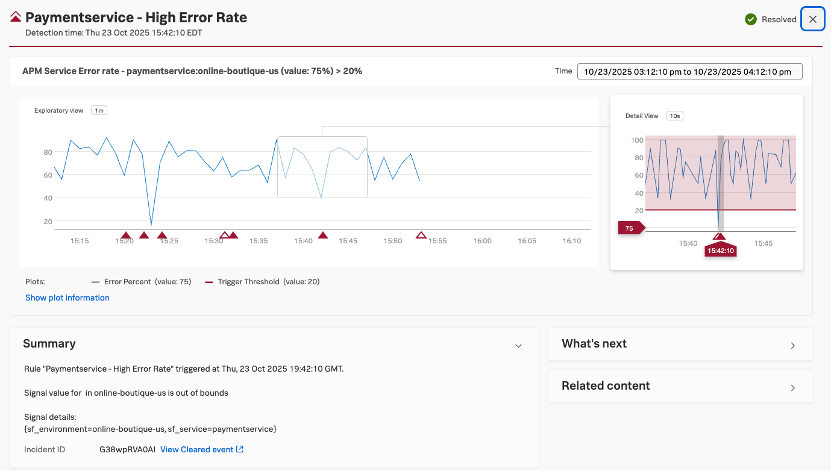Conquer Complexity, Accelerate Resolution with the AI Troubleshooting Agent in Splunk Observability Cloud

The digital landscape has transformed dramatically, and with it, the demands on our systems have grown exponentially. Traditional monitoring tools struggle to provide sufficient insight into complex, distributed, cloud-native environments. Observability is the answer, moving beyond merely knowing "what" is happening to understanding "why" it's happening, and its impact on user experience and business outcomes.
But there is further disruption on the horizon in the form of two letters you’ve probably heard far too often recently: AI.
A critical gap has emerged: while AI coding agents are dramatically accelerating the speed of code generation—pushing changes into production at unprecedented velocity—observability practices remain stuck in the old, slow paradigm. This mismatch creates a dangerous asymmetry: we can now build and deploy faster than ever, but our ability to understand, debug, and ensure reliability hasn't kept pace. The traditional approach of manually reviewing dashboards and reactive troubleshooting simply cannot match the pace of AI-driven development cycles.
However, Agentic AI is redefining what observability looks like and can achieve. No longer will an army of SREs need to spend all their time reviewing dashboards. Teams will collaborate with AI agents to optimize observability tasks like debugging problems, deploying code rollbacks, or disabling feature flags. This frees engineers to be more productive, upskill with the help of AI, and focus on areas where humans excel – thinking up novel ways to solve problems, innovate, and help their business grow. When AI agents can troubleshoot and solve the basic problems, what remains are the challenging problems that require more business context, more human knowledge, and more powerful observability tools than ever before.
Let's dig in and learn more about how AI Agents in Observability Cloud can help you and your teams troubleshoot, identify root cause, and remediate issues faster.
MTTR Is Still a Key Challenge
The core challenge for organizations today is the relentless pressure to achieve faster mean time to resolution (MTTR), directly impacting critical business uptime. Modern IT environments are inherently complex, with incidents often spanning multiple entities—from services and hosts to databases—generating an overwhelming volume of metrics, traces, logs, and events. Manually sifting through this data demands deep expertise and considerable effort, particularly for L1 analysts who are the initial point of contact for incidents.
Our agent is engineered to drastically reduce the mean time to identify (MTTI) issues, which can translate into substantial cost savings from expedited triage, improved revenue streams, and minimized downtime. AI steps in to help alleviate this "toil," delivering more effective conclusions with unprecedented speed and scope.
Unlocking Faster Root Cause Analysis with AI Agents
When a user evaluates an alert or incident, the Splunk Observability Cloud AI Troubleshooting Agent immediately activates. It intelligently collects and evaluates information, correlating related metrics, traces, events, and logs across various entities to quickly identify and present different hypotheses on suspected root causes.
Imagine this scenario: As an SRE, you receive an alert notification that your Payment service is receiving errors. You check the other metrics on Payment service for latency and overall response time and APM tags to understand the scope of impact, as well as upstream services. This leads to reviewing traces with a spike of errors, then going through spans in the trace to identify stack traces. To gain confidence in this hypothesis, you repeat this several times. Ultimately, you review associate logs by progressively narrowing the scope in case RCA wasn’t clear from the traces. You may also review associated infrastructure (like the services running in a pod) in case this isn’t a code issue.
This traditional process is time-consuming and prone to human error. And with these increasingly dense and complex environments you might be missing the bigger picture about the health of your digital operations.
Now, instead of embarking on this manual deep dive through countless dashboards, logs and traces to find the root cause, the AI Troubleshooting Agent provides you with:
- A summary of the alert; including the immediate impact of the incident on affected services and user sessions.

- Suspected root cause(s), backed by clear evidence of what was analyzed. The AI Troubleshooting agent will reveal key information by browsing across all your log, metrics (real-time and custom), and trace data, as well as nodes, clusters, services, and business workflows, so you can better monitor and optimize the performance of your production environment.

- Recommended next steps to guide your troubleshooting process.
- Crucial insights into how an issue in one part of the system (e.g., infrastructure) impacts another (e.g., services).

- Integration with the AI Assistant in Splunk Observability Cloud to continue the investigation.
This "In Context" approach, seamlessly integrated into your existing alert workflow, dramatically cuts down on manual effort and time. Users can access this AI-powered analysis with a simple action. For more in-depth investigation, they can even interact with the AI Assistant in Splunk Observability Cloud to ask follow-up questions or leverage in-context links to specialized troubleshooting tools like trace analyzers and Kubernetes (K8s) nodes.
Empowering Your Teams: From Support to SREs
AI generated root cause analysis empowers every key persona involved in the troubleshooting journey:
- System Support (L1 analysts) gain immediate, actionable insights, reducing their effort and facilitating smoother onboarding for novice users.
- Site Reliability Engineers (SREs) can swiftly pinpoint root causes, allowing them to shift focus from reactive triage to proactive resolution and strategic improvements.
- Application Developers/Ops (AppDev, DevOps) receive contextual information that enables them to resolve issues within their applications more efficiently.
- Service Owners/Platform Owners gain a clearer, data-driven understanding of how incidents impact their own components.
Moving Toward Intelligent, Effortless Troubleshooting
Ultimately, the primary business value of AI Agents in Observability Cloud is to streamline the entire troubleshooting journey. By surfacing key insights and minimizing navigational steps, especially when multiple potential causes exist, we significantly reduce the mean time to identification and resolution. This robust foundation enables more advanced AI/ML capabilities in the future, including proactive conversational insights, zero-config alerts, intelligent incident correlation, and direct remediation actions.
With the AI Troubleshooting Agent, we are moving towards a future where getting to the root cause is not just faster, but often a "1-Click" experience. This isn't merely about automation; it's about intelligence that fundamentally transforms how your teams manage incidents, ensuring greater efficiency, enhanced resilience, and ultimately, a superior experience for your users.
Interested in trying this yourself? Sign up here.
Related Articles
About Splunk
The world’s leading organizations rely on Splunk, a Cisco company, to continuously strengthen digital resilience with our unified security and observability platform, powered by industry-leading AI.
Our customers trust Splunk’s award-winning security and observability solutions to secure and improve the reliability of their complex digital environments, at any scale.



